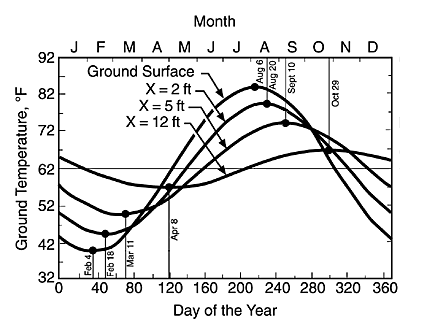6 foot down the temperature of the earth will vary seasonally, around 20' down it will stabilize (close) to the average annual air temperature of your area, normally very similar to the ground water temperature:

Notice on the graphs how the temperature stabilizes and lags behind surface temperature as the depth increases and the "wave of heat" slowly travels through the earth:


(all photos found online searching "underground temperature chart")).
Something mentioned I believe by John Hait in his book "Passive Annual Heat Storage" (currently available for download on archive.org) is that rain water soaking through the ground can greatly affect the temperature underground: if you're depending on the thermal mass of the ground, or the ground temperature then he recommends creating a water impermeable layer (usually plastic sheeting/pond liner) near the surface to prevent rain from cooling the earth or moving heat out of the thermal mass.
Edit to add: Also discussed by John in his book, if you put insulation along with the water barrier, and extend that out 20' or so in all directions, you get the temperature equivalent of 20' of covering earth without having to go down that far, since the heat in effect has to go 20' to the side because of the insulation under the water barrier.

